Spatial and Temporal Patterns of Ecological Connectivity in the Ethnic Areas, Sichuan Province, China
Abstract
1. Introduction
2. Materials and Methods
2.1. Study Area and Data Sources
2.2. Methods
2.2.1. Identify Ecological Sources and Construct Ecological Buffer Zones
2.2.2. Construction of an Ecological Resistance Surface
2.2.3. Classification of Indicators and Assignment of Values
Topography and Hydrology Dimension
Elevation
Slope
Distance from River
Ecological Environment Dimension
Land-Use Type
Value of Ecological Services
Development and Utilization Intensity Dimension
Distance from Town
Distance from Road
2.2.4. Ecological Resistance Surface Calculation
3. Results
3.1. Evolution in the Spatial and Temporal Patterns of Ecological Circulation
3.2. Spatial Clustering of Minimum Cumulative Resistance
4. Discussion
5. Conclusions
- (1)
- From 2010 to 2015, the overall ecological connectivity decreased. This is mainly reflected in the larger area and wider distribution of the high-resistance areas, while the increased resistance of the low-resistance areas leads to a more fragmented distribution. The spatial distribution of connectivity is clearly different because the resistance required to overcome the flow of ecosystem material, energy and biological information in landscapes with different ecological services is significantly lower than in human-made landscapes.
- (2)
- There are six areas of high ecological resistance characterized by human activities and ecological degradation: the Anning River Valley in Liangshan Prefecture, Ganzi, Dege and Luding counties in Ganzi Prefecture and Ruoerge and Hongyuan counties in Aba Prefecture. Low-value connectivity areas are concentrated in areas with strong anthropogenic disturbances, such as urbanization, rural settlements, industrial and mining activities, transportation and construction.
- (3)
- Low-resistance areas are more numerous and widely distributed, forming an ecological protection barrier for the three autonomous prefectures, regulating and protecting their natural environment. The high-value connectivity areas are concentrated in high-altitude plateau areas, where there is little anthropogenic disturbance and high ecological service value. Most of these areas have nature reserves distributed among them, indicating that the installation of nature reserves can effectively restore the ecosystem.
Author Contributions
Funding
Institutional Review Board Statement
Informed Consent Statement
Data Availability Statement
Acknowledgments
Conflicts of Interest
References
- WWF. Living Planet Report 2020—The Curve of Biodiversity Loss; Almond, R.E.A., Grooten, M., Petersen, T., Eds.; WWF: Gland, Switzerland, 2020. [Google Scholar]
- Ellis, J.; Lo Re, L.; De Lorenzo, F. How national governments can facilitate increased mitigation action from non-Party Stakeholders: Insights from urban renewable electricity and REDD+. In OECD/IEA Climate Change Expert Group Papers; OECD Publishing: Paris, France, 2022. [Google Scholar] [CrossRef]
- Blasi, C.; Frondoni, R. Modern Perspectives for Plant Sociology: The Case of Ecological Land Classification and the Ecoregions of Italy. Plant Biosyst. Int. J. Deal. All Asp. Plant Biol. 2011, 145, 30–37. [Google Scholar] [CrossRef]
- Wang, F.; Feng, R. Spatial Coupling and Causal Effects between the Recreational Use of Ecological Land and Restoration: A Case Study of the Pearl River Delta Urban Agglomeration. Int. J. Environ. Res. Public Health 2021, 18, 10124. [Google Scholar] [CrossRef] [PubMed]
- Guo, B.; Yang, X.; Jin, X.; Zhou, Y. A Review on the Composition and Analysis of Ecological Flow. Acta Ecol. Sin. 2015, 35, 1630–1639. [Google Scholar]
- Guan, X.; Zhang, Y.; Meng, Y.; Liu, Y.; Yan, D. Study on the Theories and Methods of Ecological Flow Guarantee Rate Index under Different Time Scales. Sci. Total Environ. 2021, 771, 145378. [Google Scholar] [CrossRef] [PubMed]
- Chen, L.; Li, X.; Fu, B.; Xiao, D.; Zhao, W. Development History and Future Research Priorities of Landscape Ecology in China. Acta Ecol. Sin. 2014, 34, 3129–3141. [Google Scholar]
- Chen, Z.; Kuang, D.; Wei, X.; Zhang, L. Development Ecological Networks Based on MSP and MCR: A Case Study in Yujiang County. Resour. Environ. Yangtze Basin 2017, 26, 1199–1207. [Google Scholar]
- Modica, G.; Praticò, S.; Laudari, L.; Ledda, A.; Di Fazio, S.; De Montis, A. Implementation of Multispecies Ecological Networks at the Regional Scale: Analysis and Multi-Temporal Assessment. J. Environ. Manag. 2021, 289, 112494. [Google Scholar] [CrossRef]
- d’Acampora, B.H.A.; Higueras, E.; Román, E. Combining Different Metrics to Measure the Ecological Connectivity of Two Mangrove Landscapes in the Municipality of Florianópolis, Southern Brazil. Ecol. Model. 2018, 384, 103–110. [Google Scholar] [CrossRef]
- Popova, E.; Vousden, D.; Sauer, W.H.H.; Mohammed, E.Y.; Allain, V.; Downey-Breedt, N.; Fletcher, R.; Gjerde, K.M.; Halpin, P.N.; Kelly, S.; et al. Ecological Connectivity between the Areas beyond National Jurisdiction and Coastal Waters: Safeguarding Interests of Coastal Communities in Developing Countries. Mar. Policy 2019, 104, 90–102. [Google Scholar] [CrossRef]
- Wang, S.; Wu, M.; Hu, M.; Fan, C.; Wang, T.; Xia, B. Promoting Landscape Connectivity of Highly Urbanized Area: An Ecological Network Approach. Ecol. Indic. 2021, 125, 107487. [Google Scholar] [CrossRef]
- Almenar, J.B.; Bolowich, A.; Elliot, T.; Geneletti, D.; Sonnemann, G.; Rugani, B. Assessing Habitat Loss, Fragmentation and Ecological Connectivity in Luxembourg to Support Spatial Planning. Landsc. Urban Plan. 2019, 189, 335–351. [Google Scholar] [CrossRef]
- Cannizzo, Z.J.; Lausche, B.; Wenzel, L. Advancing Marine Conservation through Ecological Connectivity: Building Better Connections for Better Protection. Parks Steward. Forum 2021, 37, 477–487. [Google Scholar] [CrossRef]
- Liu, Y.; Li, B.; Wang, Y.; Chen, L.; Li, X.; Hou, X. Evaluation of ecological connectivity in the coastal zone of Laizhou Bay-Yellow River Delta based on ecosystem service value. YIC-IR 2019, 39, 7514–7524. [Google Scholar]
- Cisneros-Araujo, P.; Ramirez-Lopez, M.; Juffe-Bignoli, D.; Fensholt, R.; Muro, J.; Mateo-Sánchez, M.C.; Burgess, N.D. Burgess Remote Sensing of Wildlife Connectivity Networks and Priority Locations for Conservation in the Southern Agricultural Growth Corridor (SAGCOT) in Tanzania. Remote Sens. Ecol. Conserv. 2021, 7, 430–444. [Google Scholar] [CrossRef]
- Kamila, A.; Bandyopadhyay, J.; Paul, A.K. Assessment of Landscape Ecological Connectivity for Sustainable Management of Digha–Shankarpur Coastal Tract, West Bengal, India. J. Indian Soc. Remote Sens. 2021, 49, 2701–2719. [Google Scholar] [CrossRef]
- Li, Y.; Liu, H.; Zhu, L. Landscape Integrity Assessment of Wetlands in Flood Plain of Naoli Catchment, China. Acta Ecol. Sin. 2009, 29, 4857–4864. [Google Scholar]
- Chen, L.; Liu, X.; Fu, B. Habitat fragmentation of giant pandas in Wolong Nature Reserve. Acta Ecol. Sin. 1999, 19, 3–9. [Google Scholar]
- Viña, A.; Bearer, S.; Chen, X.; He, G.; Linderman, M.; An, L.; Zhang, H.; Ouyang, Z.; Liu, J. Temporal Changes in Giant Panda Habitat Connectivity Across Boundaries of Wolong Nature Reserve, China. Ecol. Appl. 2007, 17, 1019–1030. [Google Scholar] [CrossRef]
- Bu, H.; McShea, W.J.; Wang, D.; Wang, F.; Chen, Y.; Gu, X.; Yu, L.; Jiang, S.; Zhang, F.; Li, S. Not All Forests Are Alike: The Role of Commercial Forest in the Conservation of Landscape Connectivity for the Giant Panda. Landsc. Ecol. 2021, 36, 2549–2564. [Google Scholar] [CrossRef]
- Li, Q.; Dai, L.; Zhu, Q.; Yang, G.; Wu, S. Ecological Connectivity Changes and Its Pattern Optimization during Land Consolidation Based on Minimal Accumulative Resistance Model. Sci. Geogr. Sin. 2014, 34, 733–739. [Google Scholar]
- Darvishi, A.; Yousefi, M.; Marull, J. Modelling Landscape Ecological Assessments of Land Use and Cover Change Scenarios. Application to the Bojnourd Metropolitan Area (NE Iran). Land Use Policy 2020, 99, 105098. [Google Scholar] [CrossRef]
- Sun, X.; Liu, H. Optimization of Wetland Landscape Patterns Based on Ecological Function Evaluation: A Case Study on the Coastal Wetlands of Yancheng, Jiangsu Province. Acta Ecol. Sin. 2010, 30, 1157–1166. [Google Scholar]
- Ding, X.; Shan, X.; Chen, Y.; Li, M.; Li, J.; Jin, X. Variations in Fish Habitat Fragmentation Caused by Marine Reclamation Activities in the Bohai Coastal Region, China. Ocean Coast. Manag. 2020, 184, 105038. [Google Scholar] [CrossRef]
- Jiuge, F.; Qianwei, L.; Chen, L.; Xiaoya, Z.; Yi, Y.; Junqin, G. Landscape index analysis of hydrological connectivity dynamics in the Yellow River Delta. J. Beijing Norm. Univ. Nat. Sci. 2021, 57, 12–21. [Google Scholar]
- Wu, Z.; Wang, H. Construction and Optimization of Greenland Ecological Network in Yangzhou City. J. Ecol. 2015, 34, 1976–1985. [Google Scholar] [CrossRef]
- Zhang, L.; Peng, J.; Liu, Y.; Wu, J. Coupling Ecosystem Services Supply and Human Ecological Demand to Identify Landscape Ecological Security Pattern: A Case Study in Beijing–Tianjin–Hebei Region, China. Urban Ecosyst. 2017, 20, 701–714. [Google Scholar] [CrossRef]
- Wu, M.; Hu, M.; Wang, T.; Fan, C.; Xia, B. Recognition of Urban Ecological Source Area Based on Ecological Security Pattern and Multi-Scale Landscape Connectivity. Acta Ecol. Sin. 2019, 39, 4720–4731. [Google Scholar]
- Li, T.; Gong, Y.; Ge, J.; Qi, Z.; Xie, S. Construction of Urban Landscape Ecological Security Pattern Based on Circuit Theory: A Case Study of Hengyang City, Hunan Province, China. Chin. J. Appl. Ecol. 2021, 32, 2555–2564. [Google Scholar]
- Pan, J.; Liu, X. Landscape Ecological Risk Assessment and Landscape Security Pattern Optimization in Shule River Basin. Chin. J. Ecol. 2016, 35, 791–799. [Google Scholar]
- Zhang, R.; Pu, L.; Li, J.; Zhang, J.; Xu, Y. Landscape Ecological Security Response to Land Use Change in the Tidal Flat Reclamation Zone, China. Env. Monit. Assess. 2016, 188, 1–10. [Google Scholar] [CrossRef]
- Pascual-Hortal, L.; Saura, S. Comparison and Development of New Graph-Based Landscape Connectivity Indices: Towards the Priorization of Habitat Patches and Corridors for Conservation. Landsc. Ecol. 2006, 21, 959–967. [Google Scholar] [CrossRef]
- Saura, S.; Pascual-Hortal, L. A New Habitat Availability Index to Integrate Connectivity in Landscape Conservation Planning: Comparison with Existing Indices and Application to a Case Study. Landsc. Urban Plan. 2007, 83, 91–103. [Google Scholar] [CrossRef]
- Knaapen, J.P.; Scheffer, M.; Harms, B. Estimating Habitat Isolation in Landscape Planning. Landsc. Urban Plan. 1992, 23, 1–16. [Google Scholar] [CrossRef]
- Minor, E.S.; Urban, D.L. A Graph-Theory Framework for Evaluating Landscape Connectivity and Conservation Planning. Conserv. Biol. 2008, 22, 297–307. [Google Scholar] [CrossRef] [PubMed]
- Levin, N.; Lahav, H.; Ramon, U.; Heller, A.; Nizry, G.; Tsoar, A.; Sagi, Y. Landscape Continuity Analysis: A New Approach to Conservation Planning in Israel. Landsc. Urban Plan. 2007, 79, 53–64. [Google Scholar] [CrossRef]
- Wang, Y.; Gong, H.; Li, X. Landscape accessibility analysis based on minimum cumulative resistance model. Geospatial Inf. 2007, 5, 45–47. [Google Scholar]
- Chen, G.; Yuan, L.; Wang, M.; Zhao, J. Evaluation of Ecological Connectivity in the Western Mountain Region Based on the Minimum Depletion Distance Model. Sci. Technol. Manag. Land Resour. 2017, 34, 62–72. [Google Scholar]
- Wu, C.; Zhou, Z.; Wang, P.; Xiao, W.; Teng, M.; Peng, L. Evaluation of Landscape Connectivity Based on Least-Cost Model. J. Appl. Ecol. 2009, 20, 2042–2048. [Google Scholar]
- Adriaensen, F.; Chardon, J.P.; Blust, G.D.; Swinnen, E.; Villalba, S.; Gulinck, H.; Matthysen, E. The Application of ‘Least-Cost’ Modelling as a Functional Landscape Model. Landsc. Urban Plan. 2003, 64, 233–247. [Google Scholar] [CrossRef]
- Yuying, W.; Xiaobin, J.; Chunzhu, S.; Guiye, B.; Jing, L.; Yinkang, Z. Establishment of an ecological security pattern in the eastern developed regions: A case study of the Sunan District. Acta Ecol. Sin. 2019, 39, 2298–2310. [Google Scholar]
- Loss, S.R.; Ruiz, M.O.; Brawn, J.D. Relationships between Avian Diversity, Neighborhood Age, Income, and Environmental Characteristics of an Urban Landscape. Biol. Conserv. 2009, 142, 2578–2585. [Google Scholar] [CrossRef]
- Ichinose, T. Ecological Networks for Bird Species in the Wintering Season Based on Urban Woodlands. In Wild Urban Woodlands: New Perspectives for Urban Forestry; Kowarik, I., Körner, S., Eds.; Springer: Berlin/Heidelberg, Germany, 2005; pp. 181–192. ISBN 978-3-540-26859-8. [Google Scholar]
- Li, F.; Ye, Y.; Song, B.; Wang, R. Evaluation of Urban Suitable Ecological Land Based on the Minimum Cumulative Resistance Model: A Case Study from Changzhou, China. Ecol. Model. 2015, 318, 194–203. [Google Scholar] [CrossRef]
- Liang, F.; Liu, H.; Liu, S.; Qi, X.; Liu, L. Spatial Restructuring Countermeasures of Landscape Ecological Security Network in Southern Fujian: A Case Study of Jimei District in Xiamen. Econ. Geogr. 2018, 38, 231–239. [Google Scholar]
- Ye, Y.P.; Wang, S.N. Estimating Urban Suitable Ecological Land Based on the Minimum Cumulative Resistance Model: A Case Study in Nanjing, China. In IOP Conference Series: Earth and Environmental Science, Proceedings of 5th International Conference on Water Resource and Environment (WRE 2019), Macao, China, 16–19 July 2019; IOP Publishing: Bristol, UK, 2019; Volume 344, p. 012059. [Google Scholar] [CrossRef]
- Kang, J.; Zhang, X.; Zhu, X.; Zhang, B. Ecological Security Pattern: A New Idea for Balancing Regional Development and Ecological Protection. A Case Study of the Jiaodong Peninsula, China. Glob. Ecol. Conserv. 2021, 26, e01472. [Google Scholar] [CrossRef]
- Marulli, J.; Mallarach, J.M. A GIS Methodology for Assessing Ecological Connectivity: Application to the Barcelona Metropolitan Area. Landsc. Urban Plan. 2005, 71, 243–262. [Google Scholar] [CrossRef]
- Laita, A.; Kotiaho, J.S.; Mönkkönen, M. Graph-Theoretic Connectivity Measures: What Do They Tell Us about Connectivity? Landsc. Ecol 2011, 26, 951–967. [Google Scholar] [CrossRef]
- Jiang, W.; Cai, Y.; Tian, J. The Application of Minimum Cumulative Resistance Model in the Evaluation of Urban Ecological Land Use Efficiency. Arab J Geosci 2019, 12, 1–7. [Google Scholar] [CrossRef]
- Liu, Y.; Li, L.; Chen, L.; Cheng, L.; Zhou, X.; Cui, Y.; Li, H.; Liu, W. Urban Growth Simulation in Different Scenarios Using the SLEUTH Model: A Case Study of Hefei, East China. PLoS ONE 2019, 14, e0224998. [Google Scholar] [CrossRef]
- Tran, D.; Xu, D.; Dang, V.; Alwah, A.A.Q. Predicting Urban Waterlogging Risks by Regression Models and Internet Open-Data Sources. Water 2020, 12, 879. [Google Scholar] [CrossRef]
- Abulaiti, H.; Kasmu, A.; Akemu, Z. Construction and optimization of Urumqi ecological network based on the morphological spatial pattern analysis and MCR model. Sci. Soil Water Conserv. 2021, 19, 106–114. [Google Scholar]
- Ma, C.; Yang, R.; Ke, X.; Ma, Z. Construction and Optimization of Ecological Security Pattern in Yangtze River Delta Region Based on Ecological Pressure Perspective. Resour. Environ. Yangtze Basin 2022, 31, 135–147. [Google Scholar]
- Peng, W.; Zhou, J.; Xu, X.; Zhao, J. Land Utilization of Transition Zone from Chengdu Plain and Longmen Mountains Based on Landscape Ecological Security Pattern. Bull. Soil Water Conserv. 2017, 37, 65–74. [Google Scholar]
- Zhao, B.; Kreuter, U.; Li, B.; Ma, Z.; Chen, J.; Nakagoshi, N. An Ecosystem Service Value Assessment of Land-Use Change on Chongming Island, China. Land Use Policy 2004, 21, 139–148. [Google Scholar] [CrossRef]
- Costanza, R.; d’Arge, R.; de Groot, R.; Farber, S.; Grasso, M.; Hannon, B.; Limburg, K.; Naeem, S.; ONeill, R.; Paruelo, J.; et al. The Value of the World’s Ecosystem Services and Natural Capital. Nature 1997, 387, 253–260. [Google Scholar] [CrossRef]
- Xie, G.D.; Zhang, C.X.; Zhang, L.M.; Chen, W.H.; Li, S.M. Improvement of the Evaluation Method for Ecosystem Service Value Based on Per Unit Area. J. Nat. Resour. 2015, 30, 1243–1254. [Google Scholar]
- Outeiro, L.; Gajardo, C.; Oyarzo, H.; Ther, F.; Cornejo, P.; Villasante, S.; Ventine, L.B. Framing Local Ecological Knowledge to Value Marine Ecosystem Services for the Customary Sea Tenure of Aboriginal Communities in Southern Chile. Ecosyst. Serv. 2015, 16, 354–364. [Google Scholar] [CrossRef]
- Zhang, Q.; Yang, L. A study of landscape connectivity in southwestern cities based on the minimum cumulative resistance model. Jiangsu Agric. Sci. 2016, 44, 438–442. [Google Scholar] [CrossRef]
- Xu, J.; Fan, F.; Liu, Y.; Dong, J.; Chen, J. Construction of Ecological Security Patterns in Nature Reserves Based on Ecosystem Services and Circuit Theory: A Case Study in Wenchuan, China. Int. J. Environ. Res. Public Health 2019, 16, 3220. [Google Scholar] [CrossRef]
- Yan, L.; Yu, L.; An, M.; Su, H.; Li, H.; Yuan, C. Explanation of the Patterns, Spatial Relationships, and Node Functions of Biodiversity and Island: An Example of Nature Reserves in Guizhou, Southwest China. Sustainability 2019, 11, 6197. [Google Scholar] [CrossRef]
- Guo, Y.; Zeng, J.; Wu, W.; Hu, S.; Liu, G.; Wu, L.; Bryant, C.R. Spatial and Temporal Changes in Vegetation in the Ruoergai Region, China. Forests 2021, 12, 76. [Google Scholar] [CrossRef]
- Wu, H.; Zha, K.; Zhang, M.; Yang, X. Nest Site Selection by Black-Necked Crane Grus Nigricollis in the Ruoergai Wetland, China. Bird Conserv. Int. 2009, 19, 277–286. [Google Scholar] [CrossRef]
- Zhang, J.; Connor, T.; Yang, H.; Ouyang, Z.; Li, S.; Liu, J. Complex Effects of Natural Disasters on Protected Areas through Altering Telecouplings. Ecol. Soc. 2018, 23, 17. [Google Scholar] [CrossRef]
- Lu, Y.H.; Chen, L.D.; Fu, B.J.; Liu, S.L. A Framework for Evaluating the Effectiveness of Protected Areas: The Case of Wolong Biosphere Reserve. Landsc. Urban Plan. 2003, 63, 213–223. [Google Scholar] [CrossRef]
- Liu, S.; Liao, Q.; Xiao, M.; Zhao, D.; Huang, C. Spatial and Temporal Variations of Habitat Quality and Its Response of Landscape Dynamic in the Three Gorges Reservoir Area, China. Int. J. Environ. Res. Public Health 2022, 19, 3594. [Google Scholar] [CrossRef]
- Fan, Z.; Deng, C.; Fan, Y.; Zhang, P.; Lu, H. Spatial-Temporal Pattern and Evolution Trend of the Cultivated Land Use Eco-Efficiency in the National Pilot Zone for Ecological Conservation in China. Int. J. Environ. Res. Public Health 2022, 19, 111. [Google Scholar] [CrossRef]
- Wang, Z.; Bai, T.; Xu, D.; Kang, J.; Shi, J.; Fang, H.; Nie, C.; Zhang, Z.; Yan, P.; Wang, D. Temporal and Spatial Changes in Vegetation Ecological Quality and Driving Mechanism in Kokyar Project Area from 2000 to 2021. Sustainability 2022, 14, 7668. [Google Scholar] [CrossRef]
- Ding, M.; Liu, W.; Xiao, L.; Zhong, F.; Lu, N.; Zhang, J.; Zhang, Z.; Xu, X.; Wang, K. Construction and Optimization Strategy of Ecological Security Pattern in a Rapidly Urbanizing Region: A Case Study in Central-South China. Ecol. Indic. 2022, 136, 108604. [Google Scholar] [CrossRef]
- Kang, J.; Li, C.; Li, M.; Zhang, T.; Zhang, B. Identifying Priority Areas for Conservation in the Lower Yellow River Basin from an Ecological Network Perspective. Ecosyst. Health Sustain. 2022, 8, 2105751. [Google Scholar] [CrossRef]
- He, R.; Li, L.; Zhao, Y. Analysis of Spatial Variation in Livelihood Outcomes of Poor Mountain Farmers in Liangshan Prefecture. Agric. Technol. Equip. 2017, 335, 23–25. [Google Scholar]
- Zhang, X.; Lu, X. Multiple Criteria Evaluation of Ecosystem Services for the Ruoergai Plateau Marshes in Southwest China. Ecol. Econ. 2010, 69, 1463–1470. [Google Scholar] [CrossRef]
- Li, Z.; Wang, Z.; Brierley, G.; Nicoll, T.; Pan, B.; Li, Y. Shrinkage of the Ruoergai Swamp and Changes to Landscape Connectivity, Qinghai-Tibet Plateau. Catena 2015, 126, 155–163. [Google Scholar] [CrossRef]

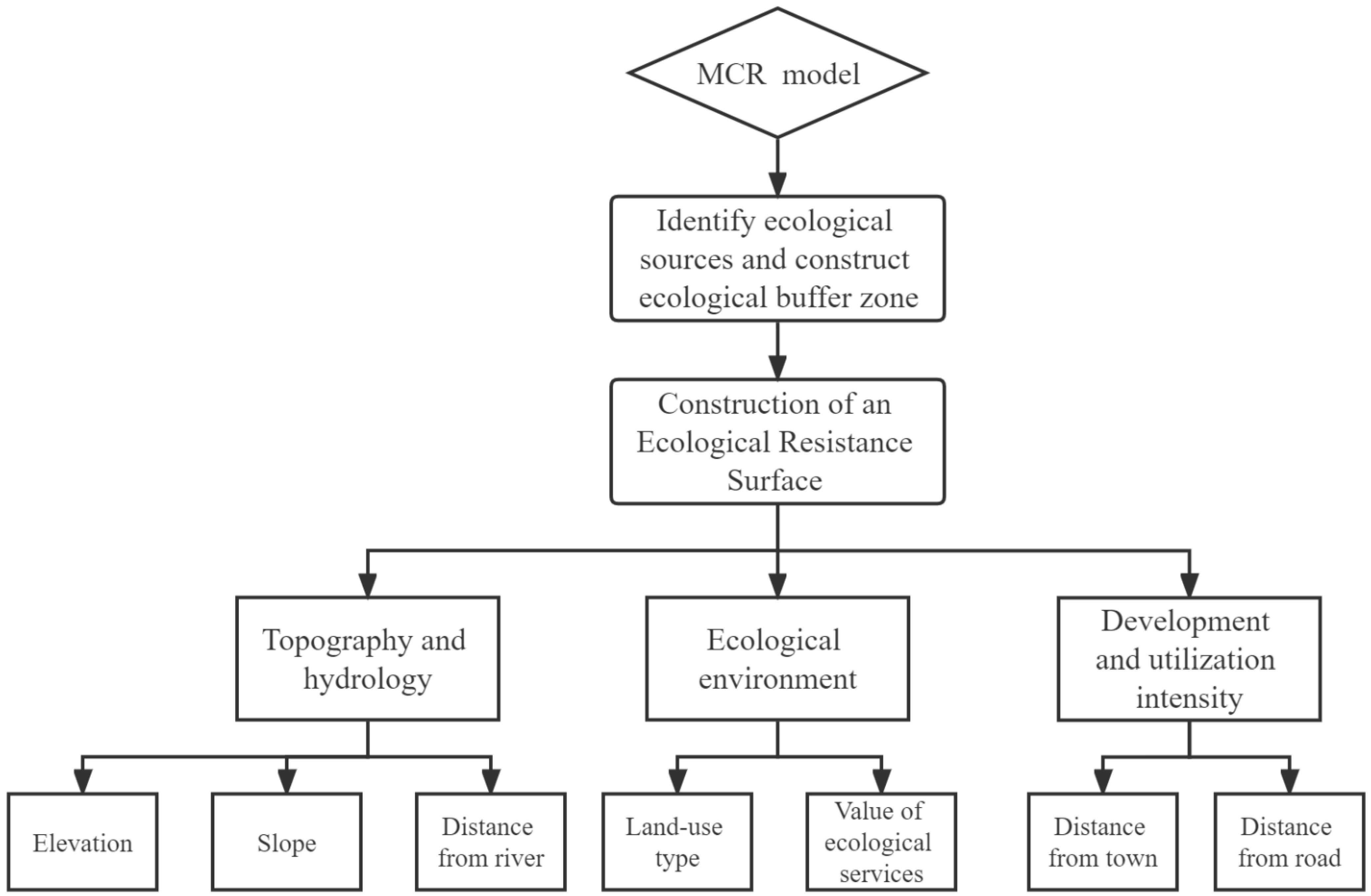
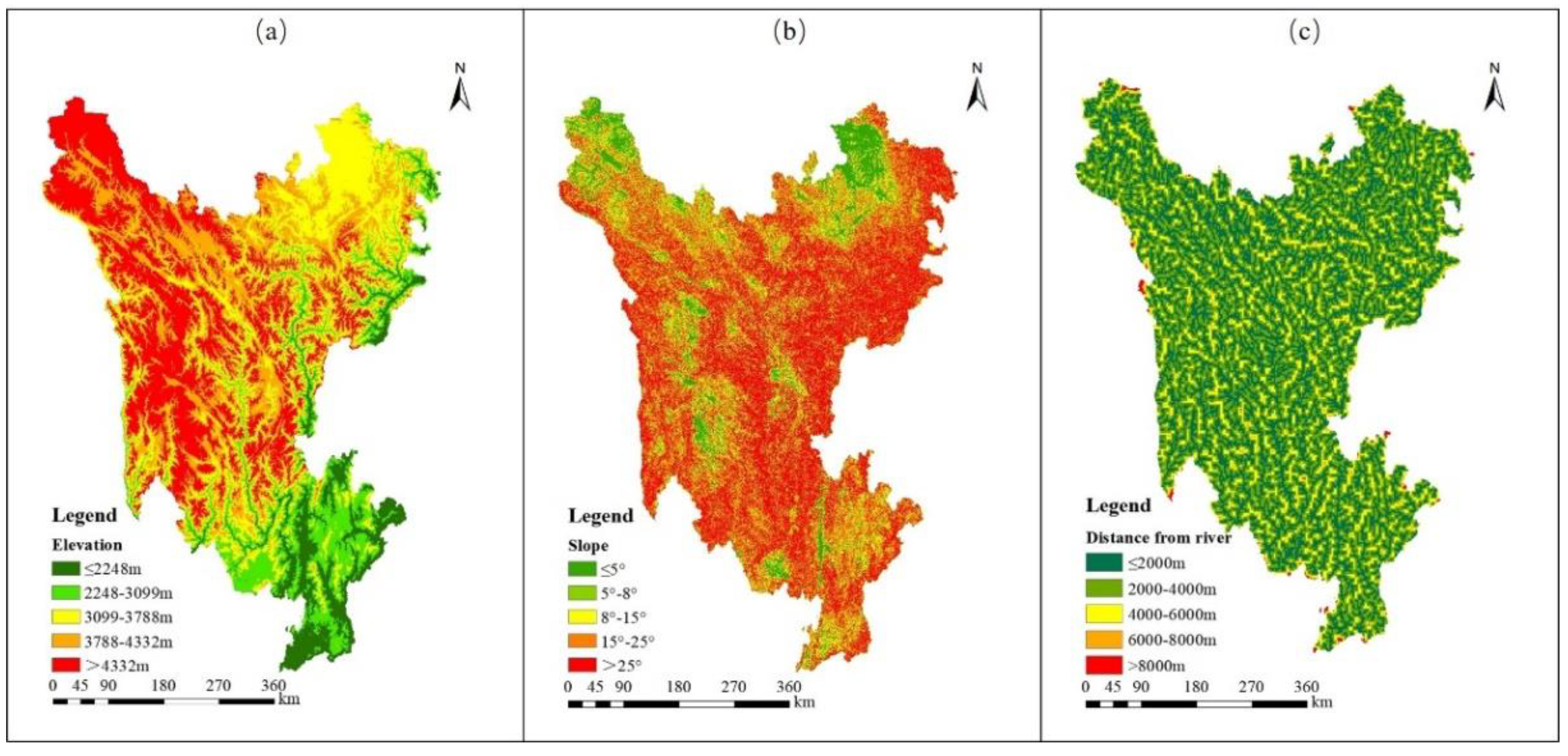


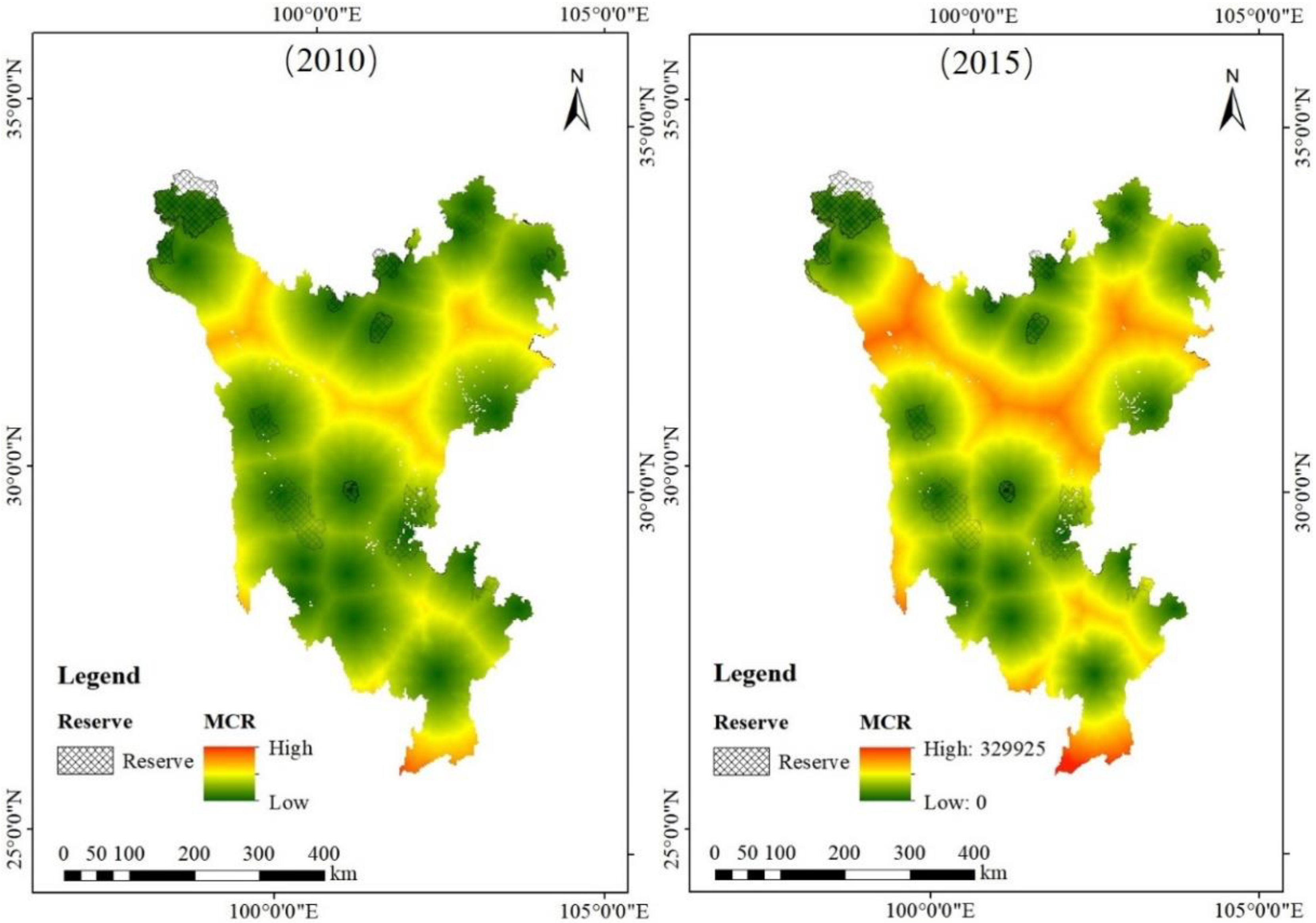
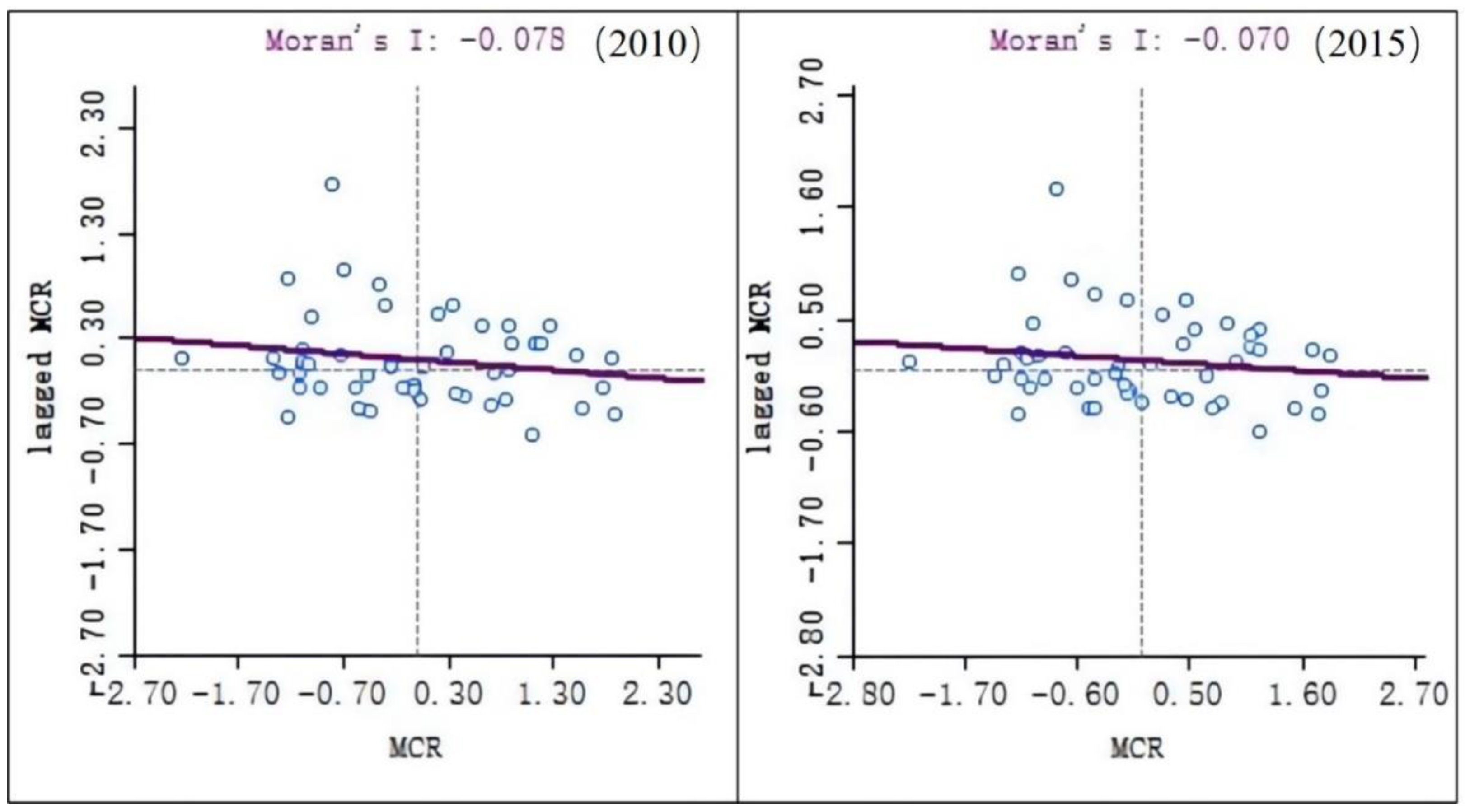
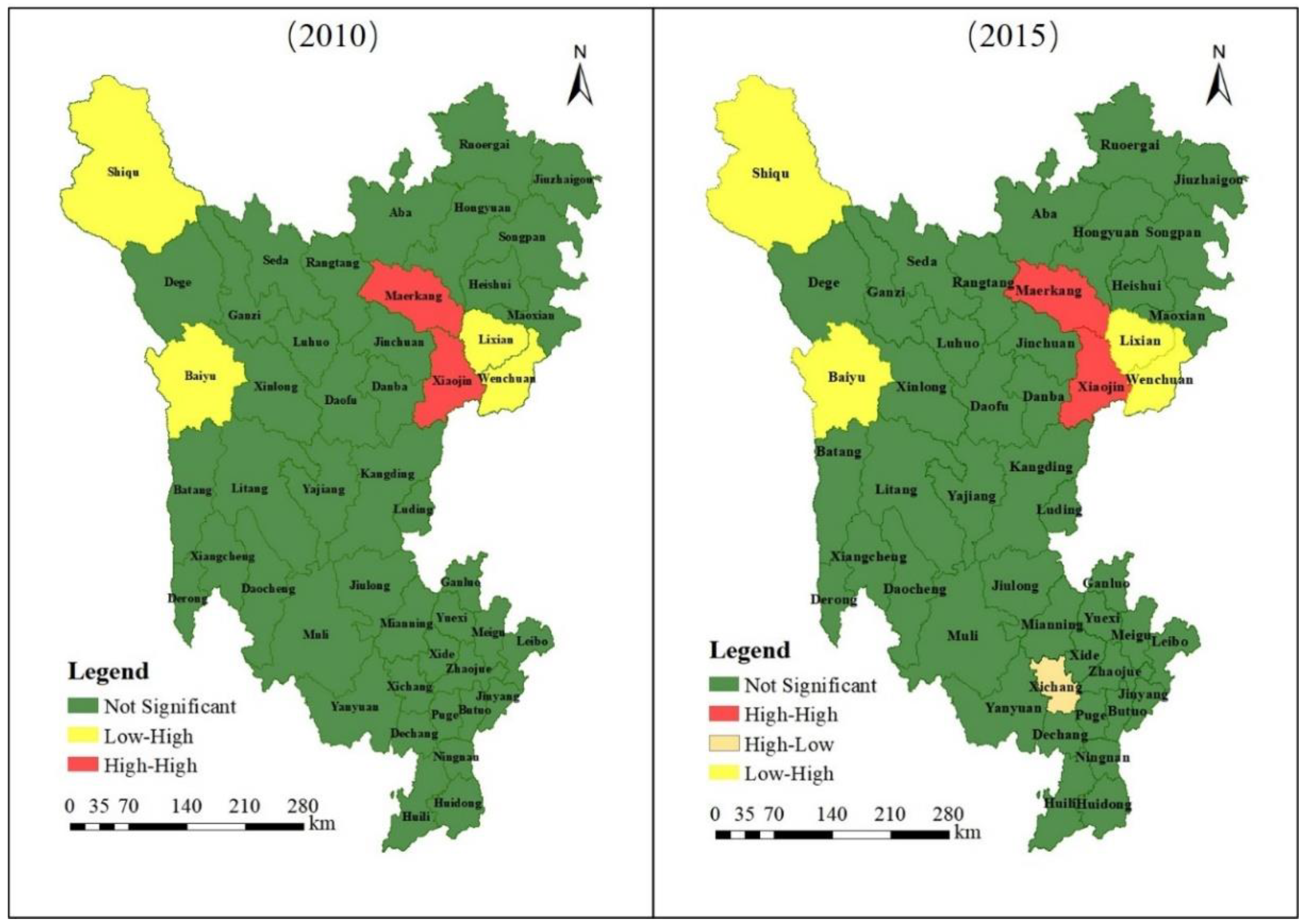
| Resistance Factor | Evaluation Factor | Weight |
|---|---|---|
| Topography and hydrology | Elevation | 0.04 |
| Slope | 0.04 | |
| Distance from river | 0.12 | |
| Ecological environment | Land-use type | 0.14 |
| Value of ecological services | 0.16 | |
| Development and utilization intensity | Distance from town | 0.28 |
| Distance from road | 0.12 |
| Resistance Factor | Evaluation Factor | Level | Resistance Value |
|---|---|---|---|
| Topography and hydrology | Elevation | ≤2248 m | 5 |
| 2248–3099 m | 4 | ||
| 3099–3788 m | 3 | ||
| 3788–4332 m | 2 | ||
| >4332 m | 1 | ||
| Slope | ≤5° | 5 | |
| 5–8° | 4 | ||
| 8–15° | 3 | ||
| 15–25° | 2 | ||
| >25° | 1 | ||
| Distance from river | ≤2 km | 1 | |
| 2–4 km | 2 | ||
| 4–6 km | 3 | ||
| 6–8 km | 4 | ||
| >8 km | 5 |
| Resistance Factor | Evaluation Factor | Level | Resistance Value |
|---|---|---|---|
| Ecological environment | Land-use type | Built Land | 5 |
| Unbuilt Land | 3 | ||
| Cropland | 3 | ||
| Grassland | 2 | ||
| Forest land | 1 | ||
| Watersheds | 1 | ||
| Value of ecological services | High | 1 | |
| Medium | 2 | ||
| Low | 3 |
| Tier 1 Type | Tier 2 Type | Comparison with Constaza Classification | Definition of Ecological Services |
|---|---|---|---|
| Supply Service | Food production | Food production | Conversion of solar energy into plant and animal products that can be consumed |
| Raw material production | Raw material production | Conversion of solar energy into bioenergy for human use in buildings and other applications | |
| Regulation Service | Gas regulation | Gas regulation | Ecosystems maintain the balance of chemical components of the atmosphere, absorbing SO2, fluoride, and nitrogen oxides |
| Climate regulation | Climate regulation | Regulation of regional climate, such as increasing precipitation and decreasing temperature | |
| Hydrological regulation | Water conditioning, water supply | Freshwater filtration, retention and storage functions of ecosystems and supply of freshwater | |
| Waste treatment | Waste disposal | Preparation and biological role in the removal and decomposition of excess nutrients and compounds, dust retention | |
| Support Services | Soil maintenance | Erosion control can maintain sediment, soil formation, nutrient cycling | Organic matter accumulation and the role of vegetative root material and organisms in soil conservation, nutrient cycling and accumulation |
| Maintaining biodiversity | Pollination, biological control, habitat, genetic resources | Genetic origin and evolution of wild plants and animals, wild plant and animal habitats | |
| Cultural Services | Providing aesthetic landscapes | Recreation, culture | Landscapes with (potential) recreational use, cultural and artistic value |
| Resistance Factor | Evaluation Factor | Level | Resistance Value |
|---|---|---|---|
| Development and utilization intensity | Distance from town | ≤2 km | 5 |
| 2–3 km | 4 | ||
| 3–4 km | 3 | ||
| 4–5 km | 2 | ||
| >5 km | 1 | ||
| Distance from road | ≤0.5 km | 5 | |
| 0.5–1 km | 4 | ||
| 1–2 km | 3 | ||
| 2–5 km | 2 | ||
| >5 km | 1 |
Publisher’s Note: MDPI stays neutral with regard to jurisdictional claims in published maps and institutional affiliations. |
© 2022 by the authors. Licensee MDPI, Basel, Switzerland. This article is an open access article distributed under the terms and conditions of the Creative Commons Attribution (CC BY) license (https://creativecommons.org/licenses/by/4.0/).
Share and Cite
Guo, S.; Deng, X.; Ran, J.; Ding, X. Spatial and Temporal Patterns of Ecological Connectivity in the Ethnic Areas, Sichuan Province, China. Int. J. Environ. Res. Public Health 2022, 19, 12941. https://doi.org/10.3390/ijerph191912941
Guo S, Deng X, Ran J, Ding X. Spatial and Temporal Patterns of Ecological Connectivity in the Ethnic Areas, Sichuan Province, China. International Journal of Environmental Research and Public Health. 2022; 19(19):12941. https://doi.org/10.3390/ijerph191912941
Chicago/Turabian StyleGuo, Shili, Xian Deng, Jiaxuan Ran, and Xiangyu Ding. 2022. "Spatial and Temporal Patterns of Ecological Connectivity in the Ethnic Areas, Sichuan Province, China" International Journal of Environmental Research and Public Health 19, no. 19: 12941. https://doi.org/10.3390/ijerph191912941
APA StyleGuo, S., Deng, X., Ran, J., & Ding, X. (2022). Spatial and Temporal Patterns of Ecological Connectivity in the Ethnic Areas, Sichuan Province, China. International Journal of Environmental Research and Public Health, 19(19), 12941. https://doi.org/10.3390/ijerph191912941







